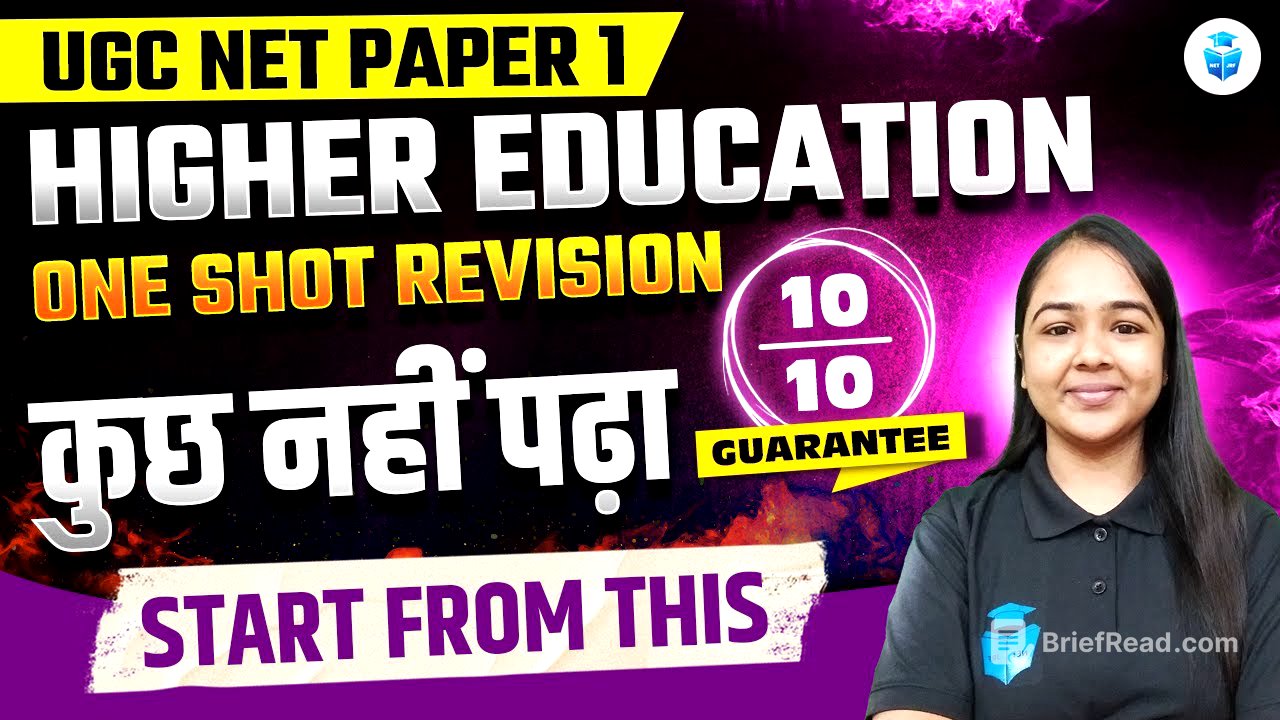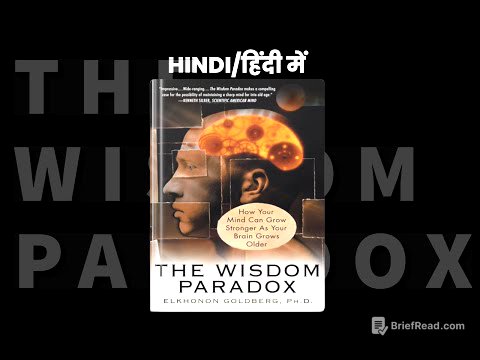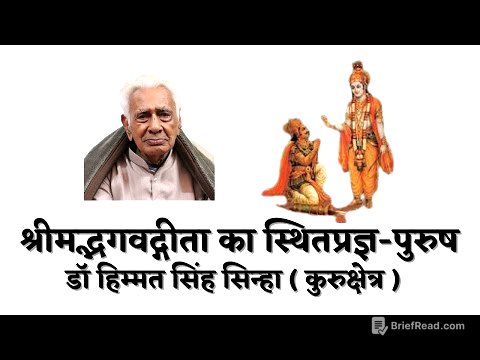TLDR;
This YouTube video provides a comprehensive review of the Higher Education unit for the UGC NET exam. It covers ancient education systems, commissions and committees, education policies, five-year plans, agencies and institutions, and government initiatives. The session aims to boost confidence and prepare students to face exam questions effectively.
- Overview of Higher Education unit for UGC NET exam
- Covers ancient education, policies, and government initiatives
- Aims to boost confidence and exam readiness
PM - Education by Mahvish Mam [7:30]
The session will cover the Higher Education unit, including ancient education systems (Vedic, Buddhist, Islamic), commissions and committees (pre- and post-independence), education policies (1968, 1986, NEP 2020), five-year plans, agencies and institutions, and government initiatives (digital initiatives and schemes). The session includes both topic summaries and practice questions to facilitate revision and practice.
Ancient Education System [3:46]
The ancient education system includes the Early Vedic, Later Vedic, Brahmanical, Buddhist, and Islamic periods. The Early Vedic period emphasized oral tradition and knowledge of the Rigveda. The Later Vedic period expanded knowledge to include the other three Vedas, Upanishads, and Vedangas, with the Upanyaay ceremony marking the start of education. The Brahmanical period saw societal divisions and limited educational opportunities for Shudras, with Gurukuls dominating and Sanskrit as the primary language. The Buddhist period promoted equality, with monasteries (Viharas) as educational institutions and the Sub-culture ceremony as an initiation. The Islamic period saw women's education decline, with education provided in madrasas (higher education) and maktabs (primary education), and the Bismillah ceremony for initiation at 4 years, 4 months, and 4 days.
Teachers and Educational Institutions in Ancient India [10:51]
In ancient India, Acharyas provided Vedic education without fees, Upadhyays earned a livelihood by teaching Vedas and Vedangas, and Charakas were traveling scholars. Teachers who maintained home life and educated their families were called Yojana Accurate, while those teaching arts and dancing were called teachers. Gurukuls were teachers' homes, councils facilitated discussions on theology and philosophy, and Ashrams were learning centers for fire worship (Agnishthana), Vedas (Brahmasthana), and politics/economics (Vishnu Ashtana). Vidyapeeths were educational institutions started by Shankaracharya, Ghatika were learning centers in South India, Agrahara were Brahmin settlements for teaching, monasteries were Buddhist religious centers, and Basdis were Jain learning centers.
Vedas and Vedic Period Education [16:17]
The four Vedas in sequence are Rigveda (oldest, hymns to gods), Yajurveda (mantras for rituals), Samaveda (musical chants), and Atharvaveda (spells). Vedic period educational institutions included Gurukuls (teachers' homes), conferences (community-based learning), and councils (academic discourses). Teaching methods involved oral teaching, with stages of learning: Shravan (listening), contemplation (understanding), and Nidhi meditation (incorporation). Other methods included illustration, question-answer, and the disciple system (senior students teaching juniors). The Upanyaay Sanskar was the initiation ceremony, and Samvartan Sanskar was the convocation ceremony.
Later Vedic Period and Brahmanical Period [23:41]
The Later Vedic period saw increased societal divisions with four Varnas: Brahmin (priests), Kshatriya (warriors), Vaishya (traders), and Shudra (laborers). Human life was divided into four Ashramas: Brahmacharya (celibacy, education), Grihastha (family duties), Vanprastha (spiritual life), and Sanyaas (salvation). The four Purushaarthas (aims) were Dharma, Artha, Kama, and Moksha. Education included Vedanga, Upveda, Brahmana, Upanishad, and Bhagavad Gita. The six Vedangas are Matrix (position, feet), Astronomy (eyes), Phonetics (nose), Etymology (year), Ritual Kalpa (hands), and Grammar (mouth). Shruti is knowledge gained by listening, while Smriti is remembered knowledge. The Brahmanical period continued later Vedic features with increased class distinctions and discrimination, limiting education for Shudras. The main objective was to make students self-reliant and spiritually developed, with Gurukuls as institutions and verbal education as the teaching method.
Brahmanical Period Philosophers and Core Principles of Buddhism [33:15]
Famous philosophers and their books include Jupiter (Jupiter Sutra), Siddhartha Gausam (buddha tripika tripitaka), Kapila (Sankhya Sutra), Patanjali (Yoga Sutras), Kannada (Vaisheshika Sutras), Gautama (Nyaya Sutras), Jaimini (Mimansa Sutra), and Bhadra (Vedanta Sutra). Core principles of Buddhism include no ritual worship, silence on the existence of God, the Four Noble Truths, the Eightfold Path, the Middle Path, equality, non-violence, and belief in rebirth and karma. The Four Noble Truths are the existence of suffering, the cause of suffering (desire), the end of suffering, and the path to end suffering (Eightfold Path). The Eightfold Path includes right understanding, thought, speech, action, livelihood, effort, mindfulness, and concentration.
Buddhism Initiation and Islamic Period Education [40:06]
In Buddhism, the initiation ceremony was called Pabja, and the convocation ceremony was called Sub-estate. The Pabja ceremony was performed around the age of eight. Bhikshus were those with full status. The Islamic period's main objectives included intellectual development, inculcation of Islamic faith, preparation for life after death, self-realization, universal brotherhood, character and moral development, and socio-economic welfare. The Bismillah ceremony took place at 4 years, 4 months, and 4 days. Educational institutions included Maktabs (primary education) and Madrasas (higher education), with education in Arabic.
Ancient Education System Questions [44:38]
The Gurukul system aimed at self-control, knowledge preservation, social awareness, personality development, and spiritual development. The third pillar of Vedantic Sathā is Nidhi Dhyan. Vihara is related to Buddhism, Basadis to Jainism, and Agrahara to Brahminical learning. Ancient texts relate to learned disciplines, agriculture/trade, creative literature, and logic. The Indian education system is divided into Vedic, Buddhist, Muslim, British, and post-independence periods.
Ancient Universities [50:38]
Ancient universities include Ratnagiri, Vikramshila, Jagdala, Pushpagiri, Odantapuri, Sompur, Nalanda, Takshashila, and Vallabhi. Takshila is the oldest, followed by Pushpagiri, Nalanda, Vallabhi, and Vikramshila. Takshila (Pakistan) was a Brahminical learning center famous for medicine. Pushpagiri (Orissa) was a Buddhist studies center. Nalanda (Bihar) was famous for Mahayana Buddhism. Vallabhi (Gujarat) was known for Buddhist and Jain studies. Vikramshila (Bihar) was famous for Tantric Buddhism. Odantapuri (Bihar) was known for Vajrayana Buddhism. Sompur (Bangladesh) is a UNESCO World Heritage Site. Mithila was famous for Nyaya Logic. Four universities are UNESCO World Heritage Sites: Takshila (1980), Sompur Mahavihara (1985), Nalanda (2016), and Shanti Niketan (2023). Ujjain University was famous for astronomy and mathematical sciences.
Ancient Universities Questions [56:19]
Takshila University, founded by Raja Taksh, was a center of Brahmanical learning and the native land of Panini. Nalanda University was visited by the Chinese traveler Hunsang in the seventh century. Takshila was famous for medicine, Ujjain for astronomy, Vikramshila for Tantric Buddhism, and Mankhet for dual school of thought. Jagdala University is particularly famous for Vajrayana Buddhism. Vallabhi University is famous for Hinayana Buddhism. Ancient Indian universities taught logic, medicine, and philosophy. Famous scholars include Chanakya (Takshila), Nagarjuna (Nalanda), Ganesh Upadhyay (Mithila), and Kumar Jeev (Sharda Peeth). The chronological order of universities is Takshashila, Pushpagiri, Nalanda, Vikramshila, and Navdeep.
Pre and Post Independence Education Commission [1:10:54]
In the 18th century, the East India Company established educational institutes like Calcutta Madrasa (1781), Sanskrit College (1791), and Fort William College (1800). Key events include the Charter Act of 1813, Elfensto Report (1823), McElminat (1835) establishing English as the medium of instruction, Charles Wood's dispatch (1854) promoting English education, the establishment of Bombay, Madras, and Calcutta Universities (1857), the Hunter Commission (1882), the University Education Commission (1902), the Sadler Commission (1917), the Hartog Committee (1929), the Wardha Scheme (1937), and the Sergeant Plan (1944).
Pre-Independence Education Commissions and Committees [1:16:56]
Lord Macaulay's Minute (1835) focused on English education, criticized oriental culture, and introduced the Downward Filtration Theory. Woods Dispatch (1854) promoted professional training and recommended establishing universities in Presidency Towns. The Hunter Commission (1882) focused on primary education and female education. The Indian University Commission (1902) emphasized strict supervision and rigid rules for affiliated colleges. The Sadler Commission (1917) studied university problems and was influenced by the Haldane Commission. The Hartog Committee (1929) highlighted stagnation at the primary level and recommended vocational courses for average students. The Central Advisory Board of Education (CABE) was established in 1920, dissolved in 1923, and reestablished in 1935. The Wardha Scheme (1937) promoted basic education based on Gandhiji's principles. The Sergeant Report (1944) proposed dividing schools into basic schools and establishing a University Grants Committee.
Post-Independence Education Commissions and Committees [1:31:57]
Post-independence commissions include the University Education Commission (1948), the Secondary Education Commission (1952), and the Kothari Commission (1964). The first education policy was introduced in 1968, and the 42nd Constitutional Amendment in 1976 added education to the concurrent list. The second policy of education came in 1986, followed by the Ramamurthi Committee in 1992. The National Knowledge Commission came in 2005, and the Yashpal Committee Report was released in 2008-2009. The Subrahmanyam Committee Report (2016) focused on skill education, and the K Kasturi Ranganathan Committee prepared a report related to NEP 2020, which was released in July 2020.
Post-Independence Education Commissions Details [1:34:36]
The University Education Commission (Radhakrishnan Commission) focused on improving teaching staff, standards, and courses, promoting post-graduate training, professional and religious education, and reforming the examination system. The Secondary Education Commission (Muliar Commission) aimed to improve earning capacity through vocational subjects, develop human virtues, and promote leadership skills. The Kothari Commission (Indian Education Commission) covered all levels of education, emphasizing the three-language formula, university autonomy, and a 10+2+3 system. The National Knowledge Commission (Sam Pitoda Commission) focused on access to knowledge, knowledge concepts, creation of knowledge, knowledge application, and delivery of services.
National Knowledge Commission and Other Committees [1:41:18]
The National Knowledge Commission aimed to build excellence in the educational system, promote knowledge creation in science and technology, improve the management of intellectual property rights, and promote knowledge application in agriculture and industry. It recommended increasing the number of universities to 1500 and establishing an independent regulatory authority for higher education. The Yashpal Committee (2008-2009) advised on the renovation and rejuvenation of higher education and reviewed the functioning of UGC and AICTE. Other committees include the PN Sapu Committee, the Government Committee, the NN Punjaru Committee, and various committees related to women's education.
Committees on Education and International Commissions [1:49:25]
The Janardhan Reddy Committee reviewed the recommendations of the Ramamurthy Committee. The NR Sarkar Committee reviewed the functioning of UGC and recommended measures for improving the quality of higher education. The Mashelkar Committee worked to upgrade regional engineering institutes into NITs. The Jacques Delors Commission (International Commission on Education) discussed the needs of the 21st century and its four pillars: Learning to Know, Learning to Do, Learning to Lift Together, and Learning to Be.
Education Commission Questions [1:51:52]
The Indian University Commission focused on reorganizing university government, changing the syllabus, and changing methods of examination. In 1854, three universities were set up in India, and the progress of education had a crippling effect in Independent India. The curriculum framework is related to syllabus and teaching practices, the National Knowledge Commission to a vibrant knowledge-based society, Yashpal's comment to super regulators, and the Kothari Commission to academic freedom. The Radhakrishnan Commission recommended that higher education can be in regional language or English.
Education Policies and Committees Questions [1:58:39]
The Ramamurthy Committee focused on decentralization, post-graduate teaching, and in-service training for university teachers. The Sapanu Committee recommended moving higher education from the State List to the Concurrent List. The Radhakrishnan Commission recommended a minimum duration of two years for PhD.
Education Policies [2:02:47]
The 1968 policy focused on science education, improving teachers' status, language development, promoting agriculture and industrial education, equal educational opportunities, free and compulsory education, and part-time education. The 1986 policy focused on early childhood care, a national education system, equal opportunity, minimum learning level, lifelong education, women's literacy, minority education, and Navodaya schools. The Operation Blackboard scheme aimed to provide essential facilities in primary schools. The Ramamurthy Committee made modifications to the 1986 policy.
Five Year Plans [2:13:46]
The first five-year plan (1951-56) established the UGC and IIT Kharagpur, focusing on the agriculture sector. The second five-year plan (1956-61) established IIT Madras, Delhi, and Bombay, focusing on the industrial sector. The third five-year plan (1961-66) focused on economic development and technological advancement, establishing regional engineering colleges. The fifth five-year plan (1974-79) focused on establishing autonomous colleges. The eighth five-year plan (1992-97) focused on revitalizing infrastructure and system in education. The ninth five-year plan launched the Sarva Shiksha Abhiyan. The 10th five-year plan focused on increasing the enrollment ratio and vocationalization. The 11th five-year plan launched the mid-day meal scheme. Niti Aayog replaced the Planning Commission in 2015.
Agencies and Institutions: UGC and NCTE [2:22:47]
The University Grants Commission (UGC) was initially responsible for managing Delhi, Banaras, and Aligarh Universities in 1945. In 1947, it covered all Indian universities. In 1952, the government decided that UGC would be responsible for grant-in-aid. It was officially established as a committee in 1953 and became a statutory body in 1956. UGC has six regional offices in Bangalore, Bhopal, Guwahati, Hyderabad, Kolkata, and Pune, with its headquarters in New Delhi. UGC's Inter University Centres include IUAC, IUCAA, CSR, CEC, Inflibnet, NAAC, and IUCTE. The first chairman of UGC was Dr. Shanti Swaroop Bhatnagar. The current chairman is Dr. Vinit Joshi. The National Council for Teacher Education (NCTE) was established in 1995 and is related to teacher education.
National Institutions and Research Institutes [2:31:39]
NCERT was established in 1961 and is related to text books and educational research. SCERT is the State Council of Educational Research and Training. AICTE was established in 1945 and is related to technical education. NAAC was established in 1994 and provides accreditation. The National Board of Accreditation (NBA) is for technical institutions. CBSE was established in 1929. The National Medical Commission was established in 2020 and is related to medical education. The Bar Council of India is related to legal education. The Indian Council of Agricultural Research was established in 1989 and is related to agriculture. Research institutes include ICHR, ICPR, IIAS, ICSSR, NCRI, CSIR, and the Indian Institute of Astrophysics.
Autonomous Research Institutes and Government Initiatives [2:35:51]
Autonomous research institutes include IISc, ICMR, ICAR, CSIR, ICSSR, IIA, and ICHR. Institutions affiliated to MARD include IISc, IIT Kharagpur, the Central Hindi Institute, the Central Institute of Indian Languages, the National Sanskrit Institute, Lakshmibai National Institute of Physical Education, Netaji Subhas National Institute of Sports, and the Institute of Management. Open Universities include Dr. Bhimrao Ambedkar Open University (1982), IGNOU (1985), and 16 State Open Universities. Government initiatives for education include IRIS, Xi RNI, Vidyamitra, Gian, Imprint, ARIIA, Saransh, Shala Siddhi, Shala Darpan, e-bag, e-library, PME Vidya, Jupiter, and clouds.
Government Initiatives for Education Details [2:46:48]
Digital initiatives include Swayam (online courses), Swayam Prabha (DTH channels), the National Digital Library (online library), EPG School (online content), Shodhganga (thesis repository), Shodhgangotri (synopsis repository), Shodh Chakra (research cycle), and Shodh Shuddhi (plagiarism detection software). The Academic Bank of Credit allows students to save and transfer credits. The Samarth portal is for e-governance. Other initiatives include DIKSHA, IRIS (research information), Xi RNI (women researchers), Vidyamitra (e-content), Gian (academic networks), Imprint (research innovation), ARIIA (innovation achievement), Saransh (decision support), Shala Siddhi (evaluation program), Shala Darpan (e-governance platform), e-bag (digital school books), and e-library (digital library).
Government Schemes for Education [2:57:01]
Government schemes include IRIS (research information), Xi RNI (women researchers), Vidyamitra (e-content), Gian (academic networks), Imprint (research innovation), ARIIA (innovation achievement), Saransh (decision support), Shala Siddhi (evaluation program), Shala Darpan (e-governance platform), e-bag (digital school books), e-library (digital library), PME Vidya (multi-mode education), Jupiter (content delivery system), clouds (virtual space), Expert India (literacy and numeracy), Spark (research collaboration), Impress (social science research), Stars (science research), Stride (trans-disciplinary research), Shreyas (scholarships for SC/OBC), RUSA (higher education campaign), Advanced India Campaign (rural development), Malaviya Mission Teacher Training Program, Vidyanjali (remedial classes), and Ishaan Uday (scholarships for North Eastern Region).
Government Initiatives Questions [3:06:31]
Saransh is a decision support mechanism to help people make the best decisions for their children's future. Shala Darpan is a school management tool used by central schools. Neet is related to Artificial Intelligence. The Malaviya Mission Scheme is for the professional development of teachers, Vidyanjali for remedial classes, Gian for international experience, and Ishan Uday Scholarship is for North Eastern students. Swayam provides online courses, Swayam Prabha broadcasts educational curriculum, DIKSHA provides digital infrastructure, and EPG provides learning materials. NCTE does not provide funding for research activities.









